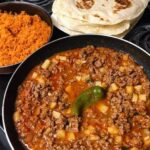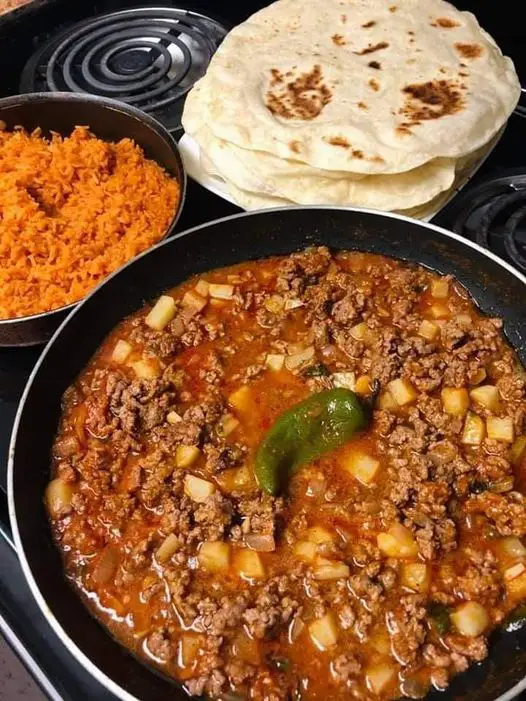The Soul of Mexican Cuisine: A Story of Picadillo
Picadillo, at its core, is a reflection of Mexican cuisine’s vibrant spirit, a dish that balances simplicity with profound flavor. Originating from the Spanish word “picar,” which means “to mince” or “to chop,” Picadillo is a versatile, minced meat dish that has been embraced and adapted across Latin America and the Philippines, each region infusing it with local flavors and ingredients. In Mexico, it’s not just food; it’s a narrative of history, colonization, and the fusion of indigenous and Spanish culinary traditions.
The Anatomy of Picadillo: Ingredients and Cultural Significance
Breaking down the ingredients of Picadillo is like reading the chapters of a culinary story. Each component, from the ground beef symbolizing the cattle ranching introduced by the Spaniards, to the indigenous potatoes and tomatoes, speaks to a confluence of cultures. The inclusion of Serrano chiles and spices like cumin, oregano, and chili powder, meanwhile, showcases the rich biodiversity of Mexico and its deep-rooted spice trade history.
Potatoes: Earth’s Bounty
Potatoes, a humble yet essential ingredient, ground the dish with their earthy flavor and comforting texture. Their journey from the Andean mountains to becoming a staple in kitchens worldwide mirrors the spread of ingredients that followed the Columbian exchange.
Beef: A Legacy of Livestock
The choice of ground beef as the protein reflects the ranching culture brought to the New World by Spanish conquistadors. It’s a nod to the pastoral landscapes that shaped much of Mexico’s agricultural and culinary development.
Tomatoes and Serrano Chiles: A Splash of Color and Heat
Tomatoes, with their juicy sweetness, and Serrano chiles, with their fiery kick, are the heart of Picadillo, painting the dish with the vibrant colors and bold flavors that Mexican cuisine is celebrated for.
Flour Tortillas: A Blanket of Comfort
Flour tortillas, while not as ancient as their corn counterparts, have become synonymous with northern Mexican cuisine. Their soft, pliable texture makes them the perfect vessel for the rich
and hearty Picadillo, allowing for a harmonious blend of flavors with each bite. The process of making tortillas from scratch—mixing, kneading, rolling, and cooking on a hot griddle—is a ritual that connects us to generations past, a testament to the handmade over the mass-produced, and a celebration of the tactile joy of cooking.
The Craft of Tortilla Making
The art of tortilla making is steeped in tradition, a skill passed down through families, a daily ritual that speaks to the importance of bread in all its forms across cultures. The transition from corn to flour tortillas in certain regions of Mexico reflects both the adaptation to available resources and the influence of Spanish culinary practices.
The Picadillo and Tortilla Symphony: A Culinary Ballet
The marriage of Picadillo with flour tortillas represents a culinary ballet, where each ingredient plays a crucial role, and the final dish is much greater than the sum of its parts. This combination is a staple of Mexican home cooking, offering a comforting, satisfying meal that can be enjoyed at any time of day.
The Versatility of Picadillo
Picadillo’s true beauty lies in its versatility. It can be enjoyed on its own, used as a filling for tacos and empanadas, or even as a base for other dishes. This adaptability makes it a beloved recipe in households across Mexico and beyond, a canvas for cooks to express their creativity and culinary heritage.
Beyond the Recipe: Nutrition, Adaptation, and Personalization
While deeply rooted in tradition, Picadillo with Flour Tortillas also reflects contemporary culinary trends, including the movement towards healthier eating, the fusion of global flavors, and the personalization of classic dishes. Substitutions like lean ground turkey, the addition of more vegetables, or the use of gluten-free flour alternatives for tortillas allow this dish to be adapted to meet dietary needs and personal tastes.
The Nutritional Aspect
The recipe offers a balanced meal, with protein from the beef, carbohydrates from the potatoes and tortillas, and vitamins and minerals from the tomatoes and green beans. Each component contributes to a well-rounded diet, showcasing how traditional dishes can be both nourishing and delicious.
The Cultural Exchange of Food
Picadillo with Flour Tortillas is more than just a meal; it’s a testament to the power of food as a medium for cultural exchange. It invites conversations about history, family, and the ways in which food connects us to our heritage and to each other. It’s a dish that transcends borders, adapting and evolving while remaining anchored in the flavors and traditions of Mexico.
Conclusion: A Celebration of Home Cooking
In exploring the depths of Homemade Picadillo with Flour Tortillas, we uncover not only the steps to creating a flavorful meal but also the stories, traditions, and innovations that make Mexican cuisine so rich and vibrant. This dish is a celebration of home cooking, of the joy found in the simple act of preparing food for loved ones, and of the endless possibilities that cooking offers for creativity, connection, and cultural expression.
FAQs for Homemade Picadillo with Flour Tortillas
Can I use ground turkey or chicken instead of beef for the Picadillo?
Yes, you can substitute ground beef with ground turkey or chicken for a leaner option. Keep in mind that the cooking times may vary slightly, and you might want to adjust the seasonings to complement the milder taste of poultry.
What can I use if I don’t have Serrano chiles?
If Serrano chiles are not available, you can use jalapeño peppers for a similar level of heat. If you prefer a milder taste, you can remove the seeds and membranes from the peppers before adding them to the Picadillo.
How can I make the flour tortillas if I don’t have vegetable shortening?
Vegetable shortening can be substituted with lard for a more traditional flavor, or with butter for a richer taste. If using butter, ensure it’s cold and cut into small pieces before incorporating it into the flour mixture.
Can I add other vegetables to the Picadillo?
Absolutely! Picadillo is a versatile dish, and you can add other vegetables such as carrots, peas, or bell peppers to add more color, texture, and nutritional value to the meal.
How do I store leftover Picadillo and flour tortillas?
Leftover Picadillo can be stored in an airtight container in the refrigerator for up to 3 days or frozen for up to 3 months. Flour tortillas can be kept at room temperature in a sealed bag for a few days or frozen with parchment paper between each tortilla and reheated on a skillet or microwave.
Is it possible to make the flour tortillas gluten-free?
Yes, you can make gluten-free flour tortillas by substituting all-purpose flour with a gluten-free flour blend. Keep in mind that the texture and taste may vary, and you may need to adjust the amount of water to achieve the right dough consistency.
Can the Picadillo be made in advance?
Yes, Picadillo tastes even better the next day as the flavors have more time to meld. You can prepare it in advance and gently reheat it on the stove or in the microwave before serving.
How can I ensure my flour tortillas are soft and pliable?
The key to soft and pliable tortillas is not overworking the dough and allowing it to rest before rolling and cooking. This rest period helps the gluten relax, making the tortillas easier to roll out and resulting in a softer texture.
What are some serving suggestions for Picadillo with Flour Tortillas?
Picadillo with Flour Tortillas can be enjoyed in many ways: as a filling for tacos, burritos, or quesadillas, or simply served with rice and beans on the side for a complete meal. Feel free to garnish with fresh cilantro, diced avocado, or a squeeze of lime for added flavor.
Print
Homemade Picadillo with Flour tortillas
Description
Homemade Picadillo with Flour Tortillas is a heartwarming dish that brings the rich flavors of traditional Mexican cuisine right to your table. This recipe is perfect for a comforting family dinner or a festive gathering with friends. Here’s how to create this delicious meal from scratch:
Ingredients
For Picadillo:
- 2 tbsp extra virgin olive oil (EVOO)
- 1 to 2 lbs ground beef
- 3 potatoes, cubed
- 1 can green beans or fresh (optional)
- 1 small onion, chopped
- 2 garlic cloves, minced
- 3 tomatoes, diced
- 2 Serrano chiles, chopped
- 1 tsp kosher salt (add more if needed)
- 1 tsp garlic salt
- 1/4 tsp cumin
- 1 tsp oregano, rubbed between palms
- 1 tsp chili powder
- 3 tsps paprika
- Pepper to taste
For Flour Tortillas:
- 4 cups all-purpose flour
- 1 tsp salt
- 1 tsp baking powder
- 1 cup vegetable shortening
- 1 cup warm water
Instructions
For Picadillo:
- Cook Potatoes: In a skillet, heat the extra virgin olive oil over medium heat. Add the cubed potatoes and cook until they are browned and cooked through. Once done, remove them from the pan and set aside.
- Brown the Beef: In the same skillet, add the ground beef, minced garlic, and chopped onions. Cook until the beef is browned. As it cooks, season with kosher salt, garlic salt, cumin, oregano, chili powder, paprika, and pepper to taste, ensuring the spices are well distributed throughout the beef.
- Add Vegetables and Simmer: Add the diced tomatoes and chopped Serrano chiles to the skillet. Let the mixture cook until it thickens a bit. Then, reintroduce the potatoes (and green beans if using) to the skillet. Stir well to combine and let everything simmer together for about 5 minutes.
For Flour Tortillas:
- Mix Dry Ingredients: In a large bowl, combine the all-purpose flour, salt, and baking powder. Mix these dry ingredients well.
- Incorporate Shortening: Add the vegetable shortening to the bowl. Use your hands or a pastry cutter to work the shortening into the flour mixture until it resembles coarse crumbs.
- Form the Dough: Gradually add warm water to the mixture, stirring until a dough forms. The dough should be soft but not sticky. Adjust with a little more flour or water as needed to achieve the right consistency.
- Rest the Dough: Transfer the dough to a Ziploc bag or cover it with a damp cloth. Let it rest for at least 1 hour. This resting period helps the gluten relax, making the dough easier to roll out.
- Shape and Cook Tortillas: After the dough has rested, divide it into small balls. On a lightly floured surface, roll out each ball into a thin circle. Heat a griddle or skillet over medium-high heat. Cook each tortilla until bubbles form on the surface, then flip and cook the other side until lightly browned. Keep the cooked tortillas wrapped in a cloth to stay warm.
Notes
Serve the savory picadillo with the freshly made warm flour tortillas for a truly comforting meal. The combination of the flavorful, spicy beef and potato mixture wrapped in a soft, homemade tortilla is sure to satisfy any appetite. This dish not only offers a taste of traditional Mexican cuisine but also showcases the joy of cooking from scratch. Enjoy this delicious meal with your loved ones, and feel free to customize the recipe with your favorite vegetables or adjust the spices to suit your taste

